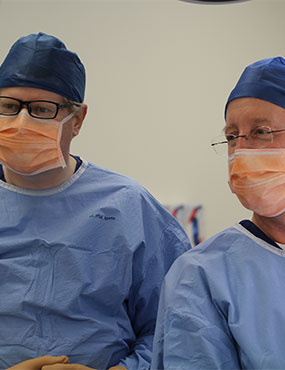Two heads are better than one for complex procedures
A new model of surgical co-operation, encouraging collaborative problem-solving, is good news for patients and surgeons alike.

Operating and problem-solving in pairs
Surgeons at Macquarie University Hospital who operate in pairs say that the model brings immense benefits to patients having complex procedures.
While Medicare recognises a surgeon having an assistant operator, it doesn’t recognise a model where two surgeons, literally, co-operate. Yet, for many surgeons, the idea of two experts working together – rather than a single expert and assistant or trainee – is one that they believe brings immense benefits to both patient and surgeon.
The point of difference with co-operating, says Professor John Cartmill, is that you’re not alone performing complex surgery. You have a colleague of equal training and experience, genuinely interested and taking the same high level of responsibility as you.
“Operating in pairs means an equal level of commitment and the ability to equally substitute at different points in a complex procedure,” said Professor Cartmill, Colorectal Surgeon at Macquarie University Hospital. “The shared position of leadership takes the pressure off a surgeon as the single, lone decision-maker. And this has to be a good thing in terms of patient outcomes.”
The Australian and New Zealand College of Surgeons recognises this co-operative approach, allocating Continuing Medical Education points when surgery is done this way. Several surgeons at Macquarie University Hospital have built their practices around being able to operate in pairs in particularly demanding situations.
The key to the success of this model is the essential respect that the two surgeons must have for one another.
“The way John and I work at Macquarie University Hospital, we have two surgeons who respect each other and recognise each other’s expertise and enjoy the combined creative learning experience,” explained Dr Gilmore.
Surgeon care and satisfaction are also part of the reason this approach is appealing.
“I think that the synergies create a whole that is significantly greater than the sum of its parts,” he said. “Outside the technical and patient outcome aspects the most interesting thing is the change in decision-making and problem-solving. The sharing of responsibility seems to help a lot in this regard.”